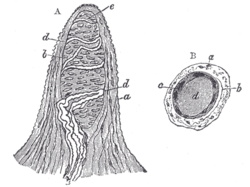Dermal papillae
| Dermal papillae | |
|---|---|
 Dermal papilla labeled at top | |
 Papilla of the hand, treated with acetic acid. Magnified 350 times. A. Side view of a papilla of the hand. a. Cortical layer. b. Tactile corpuscle. c. Small nerve of the papilla, with neurolemma. d. Its two nervous fibers running in spiral coils around the tactile corpuscle. e. Apparent termination of one of these fibers. B. Tactile papilla seen from above so as to show its transverse section. a. Cortical layer. b. Nerve fiber. c. Outer layer of the tactile body, with nuclei. d. Clear interior substance. | |
| Details | |
| Identifiers | |
| Latin | papillae dermis |
| Dorlands /Elsevier | p_03/12610332 |
| TH | H3.12.00.1.03003 |
| FMA | 70737 |
In the human skin, the dermal papillae (DP) (singular papilla, diminutive of Latin papula, 'pimple') are small, nipple-like extensions (or interdigitations) of the dermis into the epidermis. At the surface of the skin in hands and feet, they appear as epidermal or papillary ridges (colloquially known as fingerprints).
Blood vessels in the dermal papillae nourish all hair follicles and bring nutrients and oxygen to the lower layers of epidermal cells. The pattern of ridges they produce in hands and feet are partly genetically determined features that develop before birth. They remain substantially unaltered (except in size) throughout life, and therefore determine the patterns of fingerprints, making them useful in certain functions of personal identification. [1]
The dermal papillae are part of the uppermost layer of the dermis, the papillary dermis, and the ridges they form greatly increase the surface area between the dermis and epidermis. Because the main function of the dermis is to support the epidermis, this greatly increases the exchange of oxygen, nutrients, and waste products between these two layers. Additionally, the increase in surface area prevents the dermal and epidermal layers from separating from each other by strengthening the junction between them. With age, the papillae tend to flatten and sometimes increase in number. [2]
Dermal papillae also play a pivotal role in hair formation, growth and cycling. [3]
In mucous membranes, the equivalent structures to dermal papillae are generally termed "connective tissue papillae", which interdigitate with the rete pegs of the superficial epithelium.
See also
References
- ↑ "Dermal papillae". Probert Encyclopaedia. Retrieved February 2010.
- ↑ "Friction Skin". Ridges and Furrows. Retrieved February 2010.
- ↑ Lin, Chang-min et al. (October 2008). "Microencapsulated human hair dermal papilla cells: a substitute for dermal papilla?". Archives of Dermatological Research (Springer) 300 (9): 531–535. doi:10.1007/s00403-008-0852-3.
External links
- Anatomy photo: Integument/horn/horn3/horn4 - Comparative Organology at University of California, Davis - "Mammal, bovine horn (LM, Medium)"
| ||||||||||||||||||||||||||||||||||||||||||||||||